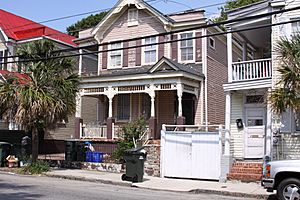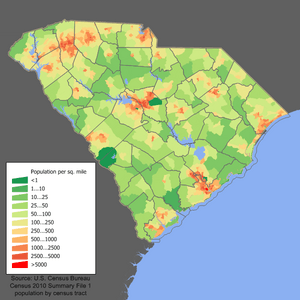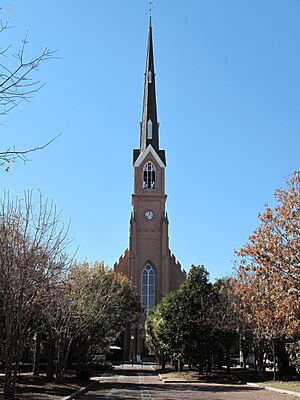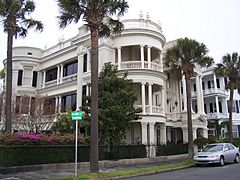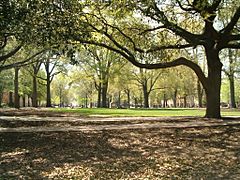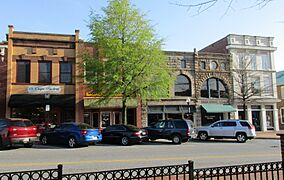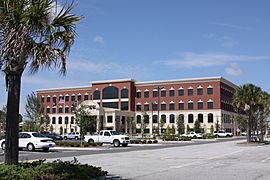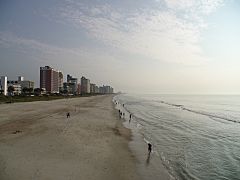Demographics of South Carolina facts for kids
South Carolina is a state located in the southern part of the United States. It's known for its beautiful coastline, historic cities, and friendly people. In 2020, about 5.1 million people lived here, making it the 23rd most populated state in the country.
Contents
Who Lives in South Carolina?
South Carolina's population has been growing steadily! Between 2010 and 2020, the number of people living in the state increased by over 493,000. That's a lot of new neighbors!
Many people have moved to South Carolina from other countries, especially from Mexico and Latin America. They often work in construction, farming, or factories. This has made South Carolina one of the fastest-growing states for people born outside the U.S.
People in South Carolina come from many different backgrounds. The largest groups include:
- African American (about 29.5%)
- American (about 13.9%)
- English (about 8.4%)
- German (about 8.4%)
- Irish (about 7.9%)
For a long time, from the 1720s until the 1920s, African Americans made up most of the state's population. This changed when many African Americans moved to northern cities for new opportunities during a time called the Great Migration. Today, most African Americans in South Carolina live in the Lowcountry and Midlands areas, which are places where they have historically lived in large numbers.
About 6.6% of people in South Carolina are under 5 years old, and 25.2% are under 18. About 12.1% are 65 or older. Slightly more than half of the population (about 51.4%) are female.
Where People Live
The "center of population" for South Carolina is like the balancing point if you could put everyone in the state on a map. It's about 2.4 miles (3.9 km) north of the State House in Columbia.
Busiest Counties
Here are the counties in South Carolina with the most people:
| County | Main City | 2000 Population | 2010 Population | 2017 Population |
|---|---|---|---|---|
| Greenville | Greenville | 379,616 | 451,225 | 506,837 |
| Richland | Columbia | 320,667 | 384,504 | 411,592 |
| Charleston | Charleston | 309,969 | 350,209 | 401,438 |
| Horry | Conway | 196,629 | 269,291 | 333,268 |
| Spartanburg | Spartanburg | 253,431 | 284,307 | 306,854 |
| Lexington | Lexington | 216,014 | 254,920 | 290,642 |
| York | York | 164,614 | 229,073 | 266,439 |
| Berkeley | Moncks Corner | 142,651 | 177,843 | 217,937 |
| Anderson | Anderson | 165,740 | 187,126 | 198,759 |
| Beaufort | Beaufort | 120,937 | 162,233 | 186,844 |
Cities and Towns
South Carolina has many interesting cities and towns. Here are some of the biggest ones, based on how many people lived there in 2010:
- Columbia – 129,272
- Charleston – 120,083
- North Charleston – 97,471
- Mount Pleasant – 67,843
- Rock Hill – 66,154
- Greenville – 58,409
- Summerville – 43,392
- Sumter- 40,524
- Hilton Head Island – 37,099
- Florence – 37,056
- Spartanburg – 37,013
- Goose Creek – 35,938
- Aiken – 29,524
- Myrtle Beach – 27,109
- Anderson – 26,686
- Greer – 25,515
- Greenwood – 23,222
- Mauldin – 22,889
- North Augusta – 21,348
- Easley – 19,993
Sometimes, the population of a city itself might seem small, but the area around it, called a "metropolitan area," can be much larger. This is because it's hard for cities in South Carolina to officially add nearby areas. For example, Myrtle Beach has a smaller city population, but its surrounding area has over 200,000 people!
The areas around Columbia, Charleston, and Greenville each have between 400,000 and 550,000 people. The combined area of Greenville, Spartanburg, and Anderson is the largest in the state, with about 1.4 million people.
Religion in South Carolina
Most people in South Carolina are Christian, especially Protestant Christians. Fewer people say they don't have a religious connection compared to the rest of the U.S. Here's a general idea of religious groups:
- Christian: 78%
- Protestant: 65% (This includes many different types of Protestant churches)
- Roman Catholic: 10%
- Other Christian groups: 3%
- Other Religions: 3%
- No Religious Affiliation: 19%
Jewish people, especially those called Sephardic Jews, have lived in South Carolina for over 300 years, particularly in Charleston. For a while, Charleston had the largest Jewish population in North America. The number of Roman Catholics in the state has been growing, partly because people are moving from northern states and from Latin American countries.
How the Population Has Changed Over Time
The U.S. Census Bureau has been counting people in South Carolina since 1790. Before that, we have estimates.
For a long time, from 1790 to 1860, the census counted people as white, black slaves, or free black. After the Civil War, the groups changed to white, black (meaning African American), and other.
Over the years, the population of South Carolina has changed a lot. For example, in the early days, enslaved African people made up a very large part of the population. After the Civil War and especially in the 20th century, more white people moved into the state, and many African Americans moved to other parts of the country. However, in recent times, the African American population has continued to be a very important part of South Carolina's culture and history.
-
Charleston – Atlantic Street at E. Battery Street
-
Columbia – USC Horseshoe – a historic part of the University of South Carolina
-
Columbia – Skyline from Arsenal Hill
-
Spartanburg – Historical buildings on West Main
-
Greenville – Skyline by night
-
Greenville – Falls in Downtown area.
-
Hilton Head Island – Harbour Town
-
North Charleston – City Hall


